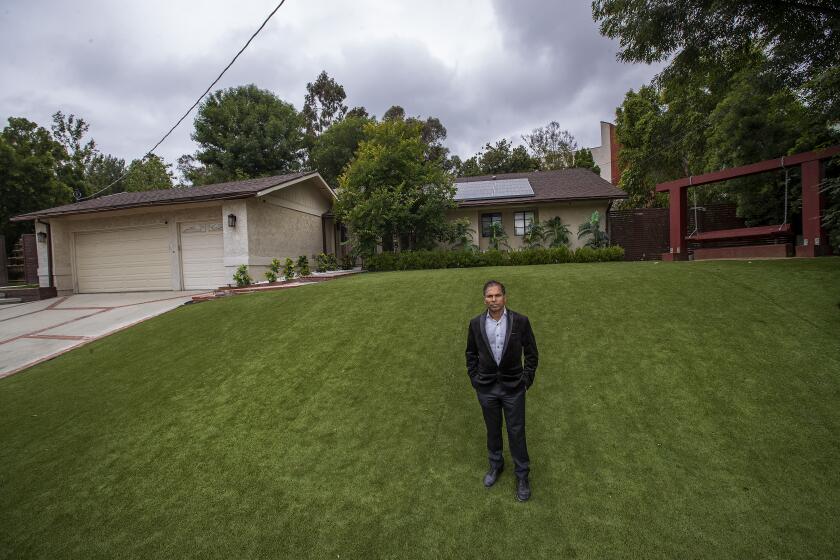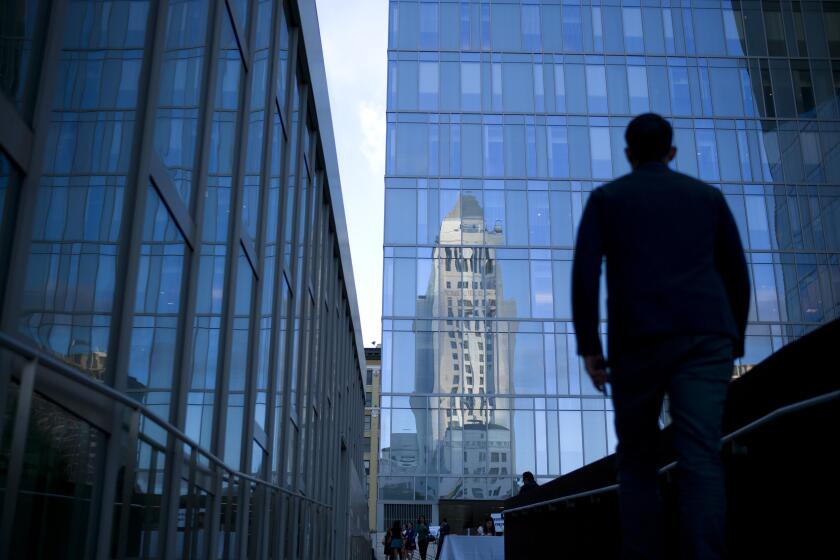Over 40,000 eviction notices have gone out in L.A. this year, many to upscale apartments
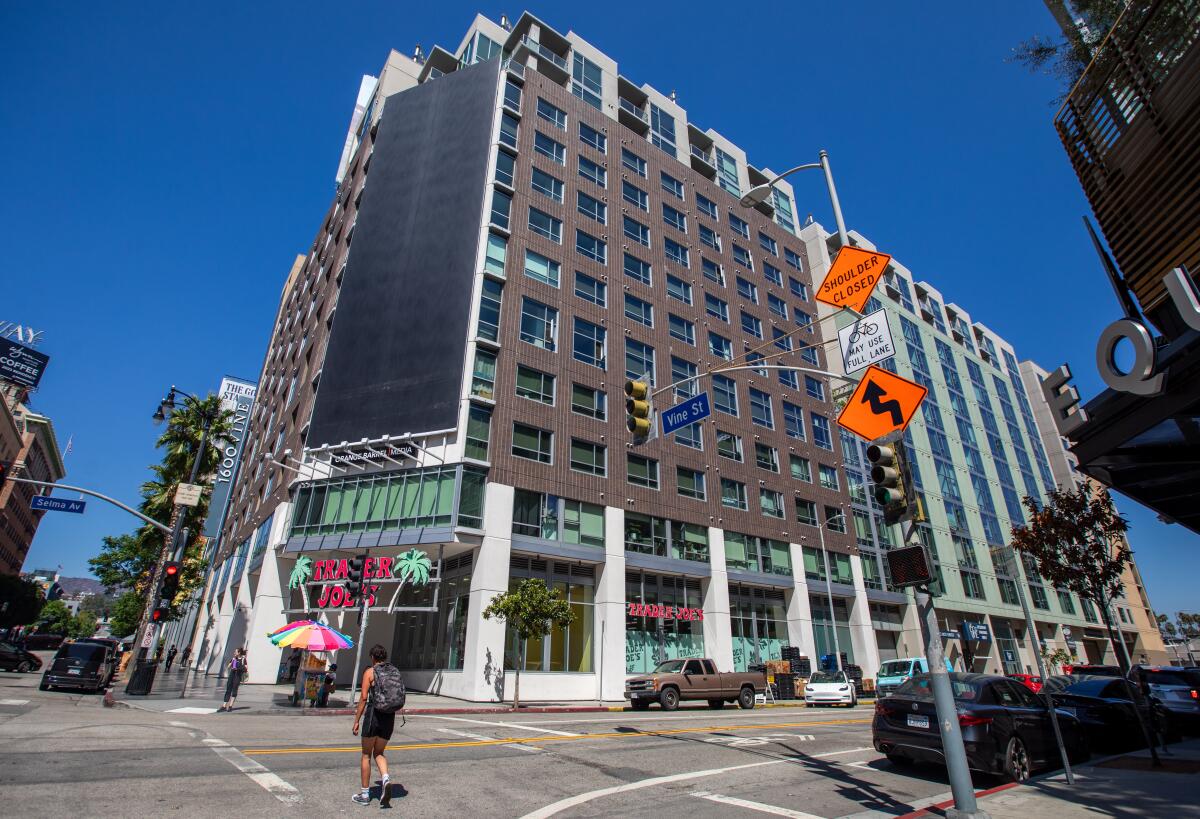
- Share via
At Promenade Towers, a Bunker Hill apartment complex with 611 units that bills itself as “an urban oasis in the heart of downtown,” tenants received 371 eviction notices from late January through July.
At 1600 Vine, a Hollywood building with 375 units that’s been known for attracting social media influencers who have posted from its balconies and manicured courtyard, 313 notices were issued in that period.
Across Los Angeles, more than 40,000 eviction notices, the vast majority of which were three-day notices to pay or move out, have been sent to tenants since late January. They were issued at buildings across the city, for amounts ranging from $0 to $561,700. The 10 buildings sending the most notices to their tenants — more than 150 each — were upscale apartments in places such as downtown, Hollywood and Woodland Hills.
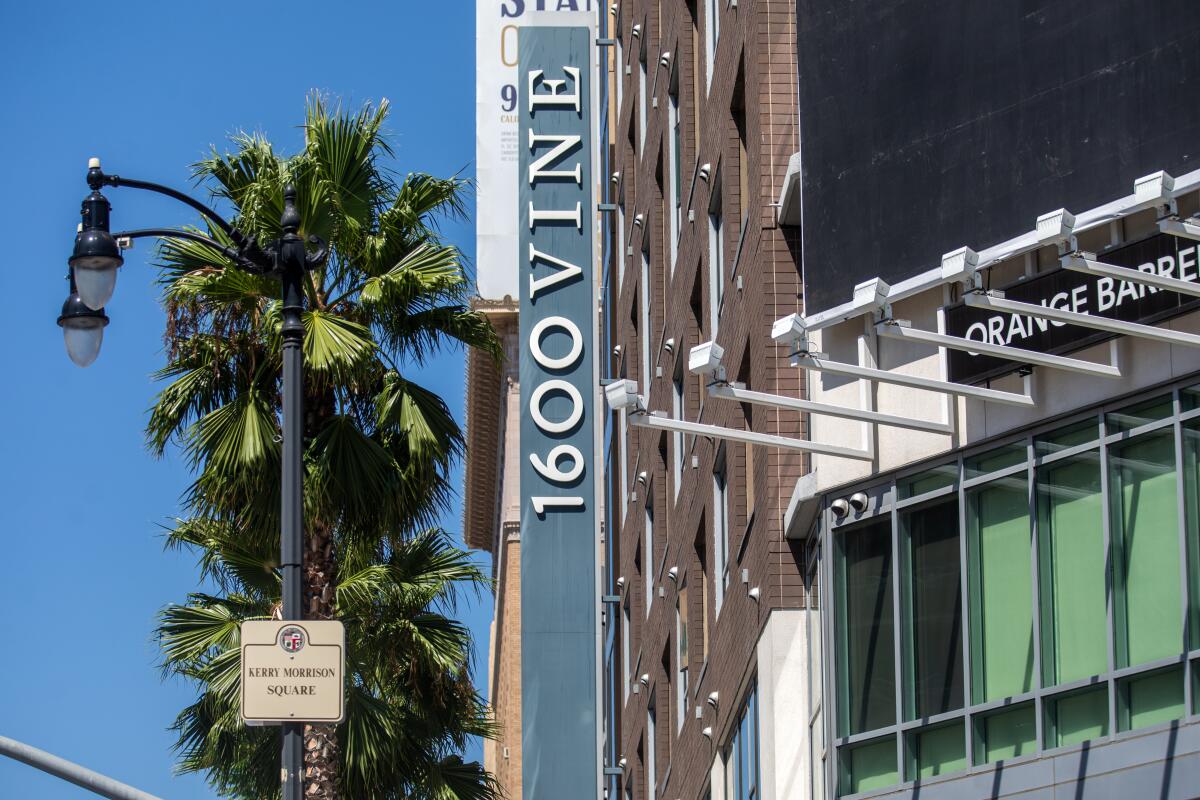
Details about the notices, which are a precursor to an eviction lawsuit, were collected by the city for the first time this year and made public by the city controller’s office. They shed light on a key step in the eviction process that until now has been shrouded in secrecy, offering a glimpse at how often tenants across the city are met with the threat of eviction.
While public perception is that tenants in low-income and gentrifying communities are most threatened with eviction, the data are in line with research showing that large property management firms tend to automate their processes and initiate eviction proceedings at higher rates, said Kyle Nelson, a senior policy and research analyst at the nonprofit advocacy group Strategic Actions for a Just Economy.
“You have extremely high-rent tenancies with extremely inflexible landlords,” said Nelson, who has been studying evictions in L.A. County for a decade.
L.A. developer Akhilesh Jha is pushing the envelope in proposing to tear down single-family homes and build apartments using new provisions in state law.
The 40,000 notices were sent to residents of about 8,400 buildings. Roughly 94% of them were notices that give tenants three days, not including weekends or court holidays, to pay any outstanding rent, fix other issues or move out, according to an analysis by the controller’s office; 96% were issued for nonpayment of rent.
The data do not capture all the eviction notices issued by landlords through the end of July. The housing department has an estimated backlog of 5,000 paper copies received in the mail it needs to enter into its database, said spokesperson Sharon Sandow. The city plans to catch up no later than October.
Some landlords said they automatically issue the notices when rent is late.
“Rent is due on the 1st and considered late on the 4th with ‘3-day pay or quit notices’ sent after the 4th as a reminder that rent is due and unpaid,” said Thomas Meredith, senior business manager for 1600 Vine. “These were only notifications that the tenant’s rent was past due.”
But by law the notices are more than reminders. They are the legal demands that come before a court case that could ultimately force a tenant from their home.
Landlords who serve notices don’t necessarily follow up with a lawsuit, however, and it’s unknown how many of the notices have translated to court action.
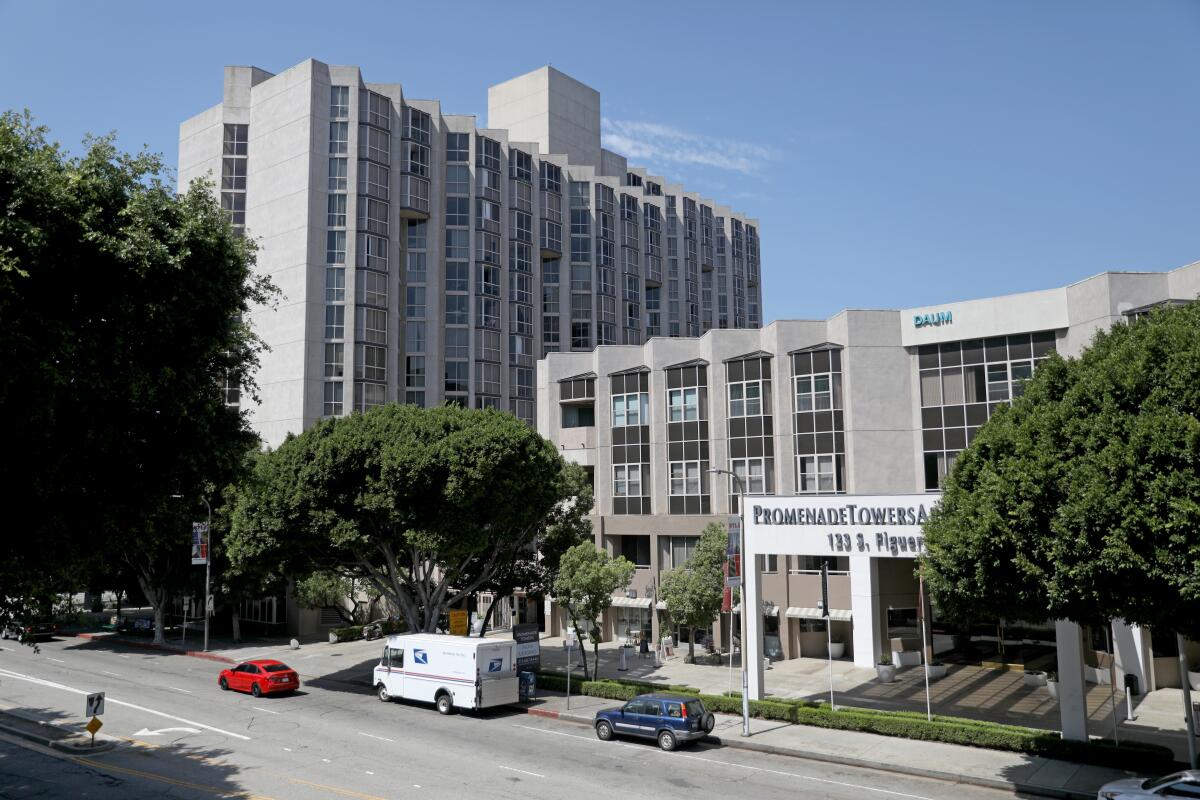
Representatives of Symmetry Apartments, a 431-unit complex in Northridge that issued 152 eviction notices, said it’s had 28 actual evictions this year, and not all were for nonpayment of rent. The complex had $2.2 million unpaid rent from the pandemic and began issuing eviction notices again in February when local emergency tenant protections ended, the landlord’s representatives said.
When those protections expired, the city adopted new rules meant to shield at-risk renters from a wave of evictions.
Among those rules is one that bars tenants from being evicted for less than one month’s fair market rent, which is determined by the number of bedrooms in an apartment and based on figures from the U.S. Department of Housing and Urban Development for Los Angeles.
According to the data, landlords issued 4,300 eviction notices for amounts below that cutoff since March 27 when the ordinance went into effect.
Under the proposal, a tenant would have to owe more than one month’s fair market rent before they could be evicted. It will need a second vote next week.
The rule only applies to rent debt incurred after that date and the data do not specify when the debt was incurred, so it is difficult to say whether landlords are complying with the rules.
Symmetry Apartments issued seven notices for amounts lower than the fair market value threshold. Representatives said they were all “sent erroneously” and they did not file lawsuits in those cases.
At 1600 Vine, about 35 three-day notices were mistakenly issued for amounts below the threshold because of a clerical error and none resulted in an eviction, Meredith said.
Citywide there were about 1,300 cases in which nonpayment of rent was cited as the reason for an eviction notice even though the rent owed was listed as $0. More than 400 were issued for amounts less than $500.
There were also a sizable number of notices sent for very large amounts. Seventeen properties saw notices issued for more than $100,000 in back rent.
Since eviction notices were not previously collected in Los Angeles, it’s not known how the number of notices compares with the past.
But court filings show that eviction lawsuits are rapidly increasing across the region.
Before plummeting during the pandemic, eviction numbers in Los Angeles had been on a gradual downward trend since the Great Recession. That direction appears to be reversing as pandemic restrictions end and landlords move to file a backlog of cases.
From January through June 2023, there were more than 23,000 eviction lawsuits filed in L.A. County, a 74% increase over the first half of 2022 and the highest first half total since 2016, according to court data collected by Nelson, the research analyst.
With Los Angeles eviction filings back at pre-pandemic levels, one woman found herself in court, pleading for more time to avoid homelessness.
The building that issued the most eviction notices in the period reflected in the data was Promenade Towers, where the least expensive one-bedroom was advertised for $2,487 a month as of Wednesday, 50% higher than the median comparable listing citywide, according to the real estate website Apartment List.
The building issued 371 notices to 170 units, more than a quarter of the total in the complex, according to the city housing department. Since July, the landlord, Goldrich Kest, which owns more than 100 apartment complexes across the country, has given out an additional 16 notices at the property, city records show.
Normally, eviction lawsuits are sealed for privacy purposes unless a landlord wins a judgment. But The Times reviewed nine eviction cases filed by Promenade Towers in August.
One was served to a 49-year-old woman living in one of the units reserved for low-income tenants. The woman, who requested anonymity out of concern for her future housing prospects, said her temporary job in property management ended soon after she moved in in early 2022. Since then, she has struggled to find consistent employment and has never paid rent.
“I haven’t been able to afford to move out,” the woman said. “Otherwise, I would have been long, long, long gone.”
All nine eviction lawsuits are for rent allegedly owed in 2022.
The City Council passed renter protections that now discourage landlords from filing eviction claims against tenants for 2022 rent not paid because of the COVID-19 pandemic. The protections are intended to shield such tenants from eviction until February 2024 provided that COVID affected their ability to pay. It’s unclear whether that’s the case for the Promenade Towers residents.
Goldrich Kest officials did not answer a written list of questions from The Times, but maintain that the eviction cases it filed are valid.
“Without getting into the particulars, Promenade Towers is in full compliance with city and county ordinances,” said Love Zepeda, a company regional director.
Niv Davidovich, an attorney representing Goldrich Kest, said that his firm has won cases despite the pandemic restrictions even when the housing department objected.
“Such evictions were entirely legal and well within landlords’ rights to file and pursue, and these judgments prove this to be the case,” Davidovich said.
Park La Brea, a rent-stabilized community that is the largest apartment complex west of the Mississippi with 4,245 units, is another hot spot for eviction notices, according to the city data.
The Times analysis counted notices given at individual addresses. While none of Park La Brea’s addresses were in the top ten for most eviction notices, collectively the complex saw hundreds.
The 10 addresses with the most eviction notices spanned several neighborhoods, with four in the San Fernando Valley and six in the Los Angeles Basin.
In many cases, the buildings had several things in common: relatively high rents and residents who said management used eviction notices as a warning after late payments.
At Motif in Woodland Hills, where at least 183 eviction notices went out this year, resident Tracey was in the process of moving out.
When paying rent in Motif’s online portal, she said, tenants are given a five-day grace period. “The second you don’t pay there’s an eviction letter on your door,” Tracey said. Prior to moving out, Tracey racked up five eviction notices for being, she said, “like a second late” on payment, often while traveling.
“They’re really big on eviction letters,” she said, declining to give her last name for fear of retaliation by the property management company she will rely on in her new complex.
Stephanie, who declined to give her last name, was walking her dog at Reveal in Woodland Hills, where at least 233 eviction notices went out this year.
The building’s lease says the landlord can serve a three-day notice any day after the first of the month.
A seven-year resident of the complex, Stephanie said she understands why people get behind on rent.
“It’s really expensive and prices go up every year in this market,” she said.
Times assistant data and graphics editor Iris Lee contributed to this report.
More to Read
Sign up for Essential California
The most important California stories and recommendations in your inbox every morning.
You may occasionally receive promotional content from the Los Angeles Times.
